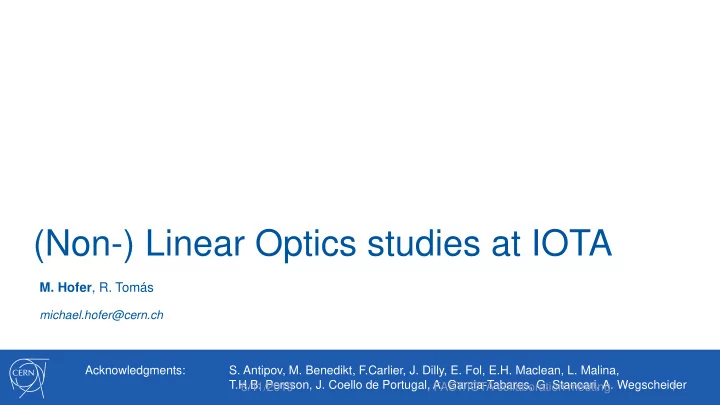

(Non-) Linear Optics studies at IOTA M. Hofer , R. Tomás michael.hofer@cern.ch Acknowledgments: S. Antipov, M. Benedikt, F.Carlier, J. Dilly, E. Fol, E.H. Maclean, L. Malina, T.H.B. Persson, J. Coello de Portugal, A. Garcia-Tabares, G. Stancari, A. Wegscheider FAST/IOTA collaboration meeting 1 6/11/2019
The IOTA ring • The IOTA ring/octagon is a unique accelerator • In terms of experimental program: octupole channel, nonlinear insert, OSC, e- lens, … But also for optics studies: • − Good control over β -function required down to the % level [1,2] − Similarly so for coupling due to working point on the diagonal (in certain modes of operation) − Inherently nonlinear while not driving resonances [1] A. Valishev et al., Beam physics of integrable optics test accelerator at Fermilab, IPAC2012, TUPPC090 [2] S. Antipov et al., Single-particle dynamics in a nonlinear accelerator lattice: attaining a large tune spread with octupoles in IOTA, 2017 JINST 12 P04008 FAST/IOTA collaboration meeting 2
Resonance Driving terms as a diagnostic tool • Goal of the proposed study is to measure resonance driving terms (RDT) in the IOTA ring • Localized measure of the distortion in phase space due to particular resonance • Longitudinal variation of amplitude of RDT used to determine sources of nonlinearities and potentially correct for F. Carlier et al., Correction of skew octupoles with A tool used in many accelerators such as • Resonance Driving Terms SPS, LHC, Tevatron, RHIC, − = 𝑦 − 𝑗𝑞 𝑦 = 2𝐽 𝑦 𝑓 𝑗 2𝜌𝜉 𝑦 𝑂+𝜔 𝑦0 ℎ 𝑦 Diamond, ESRF , … 2 2𝐽 𝑧 Τ Τ 𝑘+𝑙−1 𝑚+𝑛 2 −2𝑗 𝑘𝑔 𝑘𝑙𝑚𝑛 2𝐽 𝑦 𝑘𝑙𝑚𝑛 × 𝑓 𝑗 1−𝑘+𝑙 2𝜌𝜉 𝑦 𝑂+𝜔 𝑦0 + 𝑛−𝑚 2𝜌𝜉 𝑧 𝑂+𝜔 𝑧0 FAST/IOTA collaboration meeting 3 6/11/2019
Aiming to measure what shouldn’t be there • Ideally we will not see any RDTs present in IOTA although very nonlinear • NL-insert should not drive any resonances • Sextupolar RDTs to be expected from the chromaticity sextupoles in the T-insert • Initially focus on measuring sextupolar and octupolar RDTs First measurements/assessments can be done parasitically to some other studies • by reanalysing BPM turn by turn data • Results should provide input for future simulations and potential corrections FAST/IOTA collaboration meeting 4 6/11/2019
Linear optics studies • Extracted Turn by turn data also allows for fast linear optics measurements complementary to the previous LOCO measurements • Assessing the local coupling and correction of interest not only for non linear integrable optics Kicker but also later on for OSC AC-Dipole One particular challenge for the measurements • could arise from strong decoherence • Potential way of overcoming decoherence could be the use of running the kicker magnets with oscillating current (AC-Dipole configuration) From R. Miyamoto, FERMILAB-Thesis-2008-48 FAST/IOTA collaboration meeting 5 6/11/2019
Further studies on coupling • In addition, the possible occurrence Similarly, the impact of local coupling • of an amplitude dependent closest on RDTs but also in combination with tune approach could be studied NL-insert possibly of interest E.H. Maclean et al., Amplitude dependent closest tune approach generated by normal E.H. Maclean et al., and skew octupoles, IPAC 2017, WEPIK091 Effect of linear coupling on nonlinear 2 observables at the LHC, IPAC 2017, ∆𝑅 𝑛𝑗𝑜 ≈ 2 𝜆 2 + ℎ 1111 𝜆𝑏 1 ത ℎ 1111 𝑏 1 2 [3] ൗ 𝑏 2 − 32 𝑏 2 ത 𝑏 2 − 𝑏 1 ത WEPIK092 with 𝜆 being the linear closest tune approach, ℎ 1111 octupolar amplitude detuning term, 𝑏 1,2 phase space coordinates [3] R. Tomás et al., Amplitude dependent closest tune approach, PRAB 19, 071003 (2016) FAST/IOTA collaboration meeting 6 6/11/2019
Conclusion • Focus of the proposed study is measuring resonance driving term in IOTA • Unique in that it is very nonlinear while ideally no RDT present • Output of the proposed study hopefully valuable input for further studies and corrections • Comments/ input are very welcome FAST/IOTA collaboration meeting 7 6/11/2019
Thank you for your attention! FAST/IOTA collaboration meeting 8 6/11/2019
FAST/IOTA collaboration meeting 9 6/11/2019
Recommend
More recommend